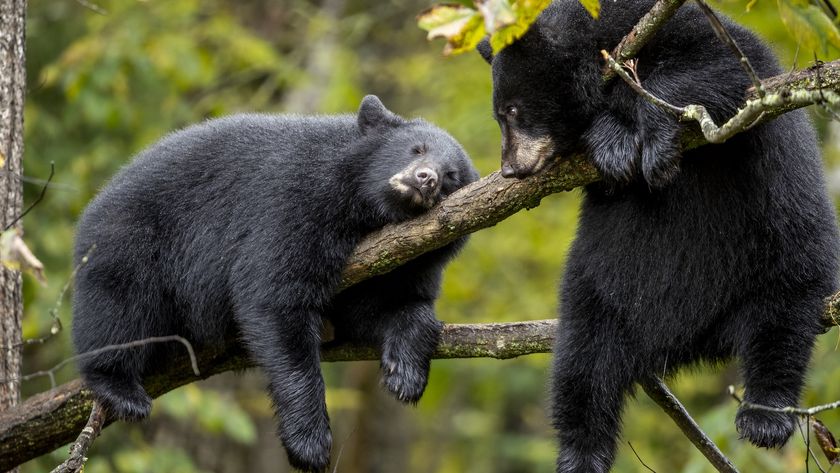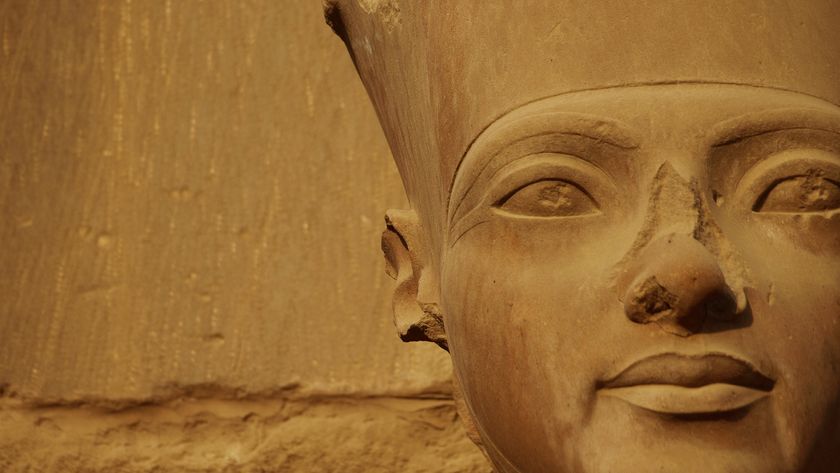Sloths: The World's Slowest Mammals
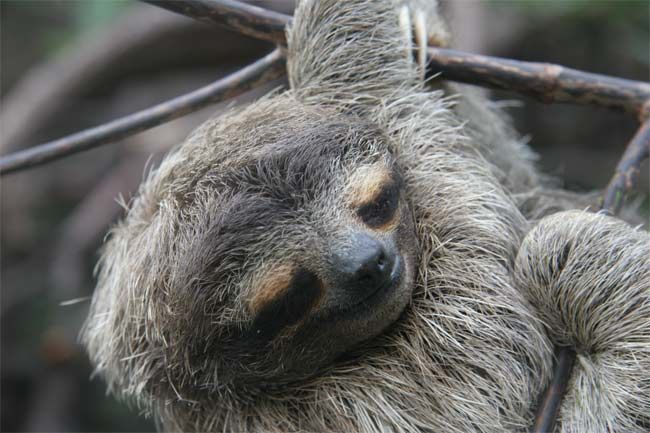
Sloths are tropical mammals that live in Central and South America. They use their long claws to hang onto branches while they feast on the leaves that other animals can't reach. The sloth's long claws — 3 to 4 inches (8 to 10 centimeters) — make walking on the ground difficult, so they spend most of their time in the tall trees they call home. [12 Extremely Strange Animal Feet]
Biology
There are six species of sloth, and they come in two varieties: two-toed and three-toed. Three-toed sloths are about the size of a medium-sized dog at around 23 to 27 inches (58 to 68 cm) and 17.5 to 18.75 lbs. (about 8 kilograms). The two-toed sloths are slightly bigger than the three-toed sloths, though they share many of the same features.
Thousands of years ago, sloths were much larger, according to the San Diego Zoo. Ancient sloths could grow to be as large as an elephant. They roamed North America and became extinct around 10,000 years ago. Sloths have an average life span of 20 to 30 years in the wild, but captive sloths tend to live a bit longer. In 2017, a captive sloth at the Adelaide Zoo in Australia died at age 43.

Compared with most mammals, sloths move very slowly. It takes them about a minute to climb only 6 to 8 feet (1.8 to 2.4 meters).
Sloths may be slow climbers, but they are speedy swimmers. They’re naturally buoyant and, like humans, sloths can do the breaststroke with ease. Because sloths inhabit rainforests prone to seasonal flooding, the ability to swim is essential to their survival. Swimming also offers sloths a means of covering more ground in less time when searching for a mate or scoping out new territory, according to Azula, a nonprofit ocean news organization.
Behavior
Sloths are solitary creatures that rarely interact with one another outside of breeding season. But sloths have little time to feel lonely given their rigorous sleep schedule. Captive sloths typically sleep for 15 to 20 hours per day, while wild sloths rarely rest for more than 10 hours, according to research by the Planck Institute for Ornithology in Starnberg, Germany. Sloths prefer sleeping while curled into a ball in the fork of a tropical tree. They also like to sleep hanging by their claws from tree branches.
Habitat
Though their ancestors lived in North America, modern sloths live in Central and South America, enjoying the tall trees found in rain, cloud and mangrove forests. Most sloths will occupy several trees during their lifetime, but some, including the three-toed species, may spend their entire lives in the tree they were born in, according to Bradley Trevor Greive's book, "Priceless: The Vanishing Beauty of A Fragile Planet" (Andrews McMeel Publishing, 2002). For the most part, a sloth's life revolves around sleeping and eating in its tree homes. These mammals come down from the treetops only to poop (which they do once a week), search for a mate or to establish new territory.
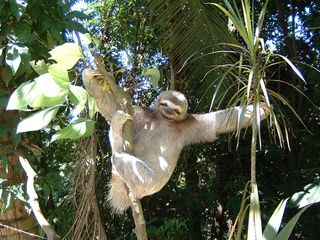
Mating habits
Sloths mate and give birth in trees. Courting starts when a female yells a shrill, monoton mating scream to let the males in the area know she is ready. If more than one male answers this call, the suitors will fight for her by hanging from branches by their feet and swiping at each other. These altercations, though rare, can be surprisingly violent. "[I’ve seen] old males with scars in their faces or even blind [in] one eye, which could possibly result from fighting against same-sex opponents," biologist and sloth researcher Adriano Chiarello of the University of São Paulo previously told Live Science.
The mating habits and gestations times of a sloth vary widely by species, Chiarello said. Three-toed sloths tend to breed during late summer to early fall and give birth early the next year, while two-toed sloth species have a "blurred reproductive schedule that happens year-round," Chiarello said.
Gestation can take anywhere from five to six months, as it does for the pale-throated sloth (Bradypus tridactylus), to 11.5 months, as it does for the Hoffman's two-toed sloth (Choloepus hoffmanni). All female sloths have only one baby at a time.
After they are born, the babies aren't in a hurry to leave their mother. They cling to their mother's belly until they are able to feed themselves, which can take anywhere from five weeks to six months, according to the Encyclopedia Britannica. Even after they stop dangling from their mother, little sloths stay by their mother's side for two to four years, depending on their species. For most species of sloth, females mature faster than male sloths, according to the San Diego Zoo. Female two-toed sloths typically reach sexual maturity at approximately 3 years of age, while males mature at 4 to 5 years of age. However, the reverse is true for the the three-toed, pale-throated sloth.
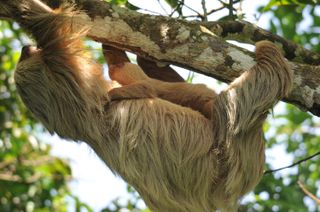
Diet
Two-toed sloths are omnivorous, meaning they can consume plants and animals. Their diet includes fruits, leaves, insects and small lizards. Three-toed sloths, on the other hand, are almost entirely herbivorous (plant eaters). Their diet consists primarily of leafs and buds from select species of tree, including the leafy cecropia tree. The leafs that make up much of the sloth’s diet are difficult to digest. But like many herbivorous mammals, sloths have a multichambered stomachs filled with symbiotic bacteria that can break down cellulose.
Sloths digest food even more slowly than they eat it. In fact, it can take up to a month for a sloth to digest a single meal, according to the Jacksonville Zoo in Florida.
Their leafy diet isn't very nutritious, so they don't get much energy from it, which could be the reason for their sluggish lifestyle.
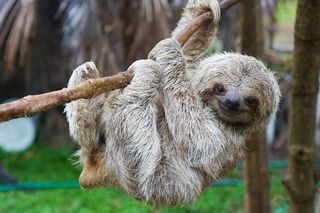
Conservation status
Despite sloths being relatively defenseless creatures, their populations aren't struggling as a whole. Nonetheless, humans pose a threat to the continued survival of sloths through deforestation and poaching. Four of the six living sloth species are rated as least concern by the International Union for Conservation of Nature and Natural Resources (IUCN). However, the maned three-toed sloth (Bradypus torquatus), native to Brazil's rapidly shrinking Atlantic Forest, is classified as vulnerable to extinction and the pygmy three-toed sloth, found only on Panama's Escudo Island, is classified as critically endangered.
More fun facts about sloths
Sloths are considered the world's slowest animal. They creep at such a slow pace that algae grows on their fur. This green algae, known as Trichophilus, grows only on the fur of sloths. More than half of all sloths harbor this algae, which gives their coarse, brownish-gray coats a greenish hue during the rainy season.
The algae works to the sloth's advantage. Having green fur provides these arboreal animals with camouflage to blend in among the trees. Staying out of sight is the sloth's best defense against its predators, which include jaguars, harpy eagles and humans.
All mammals, from humans to giraffes, have seven vertebrae in their necks — except for sloths and manatees. Two-toed sloth species have between five and seven neck vertebrae, while three-toed sloths have eight or nine. Having a few extra neck vertebrae allows three-toed sloths to rotate their heads up to 270 degrees.
This article was updated on Nov. 26, 2018, by Live Science Contributor, Annie Roth.
Sign up for the Live Science daily newsletter now
Get the world’s most fascinating discoveries delivered straight to your inbox.

